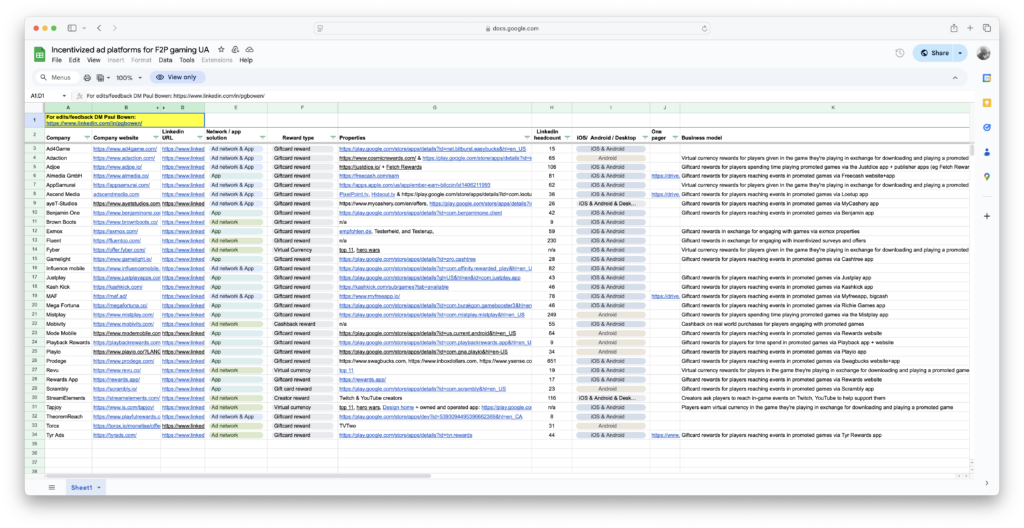Content
Stay up to date on the latest happenings in digital marketing
What is going on in the rewarded ad space? Why is it exploding? We’ve all seen the number of ad networks focused on rewarded ads and incentivized ads lately. Adtech OG Paul Bowen is seeing it too, and when he decided to take a serious look, he found 32 different ad networks focused specifically on rewarded ads for free-to-play gaming user acquisition.

So what’s going on here?
In a way, he says, it just might be all AppLovin’s fault: the ad network that has grown so fast and so big there’s almost no room to innovate in the traditional gaming user acquisition space anymore.
But of course, reality is complex: there’s clearly more going on than just AppLovin’s recent dominance.
Rewarded ad networks: how AppLovin is fueling the boom in incentivized ads
I had a chance to chat with Paul Bowen on the Growth Masterminds podcast.
He’s a legit adtech OG: former GM at a Liftoff company (AlgoLift), former VP at Unity Ads, a VP at Tapjoy, and now the chief revenue officer at StreamElements, which sounds non-adtechy but actually shares a lot of the characteristics of an ad network built on the supply side of the creator or influencer marketing boom.
Click play and keep scrolling:
Rewarded ad networks, incentivized ads: following the path of least resistance
75% of the rewarded ad networks Bowen could find revenue model details on use gift cards as their primary mode of reward. And it turns out that this is significant in terms of why there’s been an explosion in these kinds of companies.
Why?
Low barrier to entry, thanks to minimal integration complexity with participating apps.
“The barrier to entry is relatively low if the type of product you are building gives gift card rewards,” says Bowen. “With gift cards as a reward, you don’t need to work with any third party on the publisher side. You can basically spin up your own product, whether it be a web product or an app, and you own the fulfillment on the payouts, the reward side, which makes it a one-sided marketplace and a lot easier than building a two-sided marketplace.”
Virtual currency requires working with third parties, and publishers need to implement your solution to offer that currency. You need to persuade publishers, talk to product teams, convince the monetization manager …
Once you’re in it’s great, but it takes time, it’s hard, and not every publisher wants the hassle.
Major ad networks can offer large incentives, but not necessarily start-ups trying to scale. Which is a major reason why so many start-ups are doing rewarded ads or incentivized ads, but making the payments in real-world products or currencies via gift cards.
Another reason … AppLovin (and ATT)
And yes, AppLovin is part of the reason too.
When Apple’s ATT made IDFAs scarce, consolidating ad platforms became more important, as did owning your own data. Which is a big reason AppLovin acquired MoPub from Twitter a few months after ATT reached majority share, then sunsetted the product in favor of its own supply side platform Max, migrating customers over.
“AppLovin sees every ad call made,” says Bowen. “That’s why they’re so good at what they do … they own the mediation, they own the header bidding.”
They are by far the dominant player, Bowen says, and every other company in the traditional ad space is suffering as a result. After all, when you get insight into every impression filled and what price it was filled for from the supply side, you can feed that insight into your own demand side pricing strategy. That’s a massive competitive advantage: you know how each publisher values their players. After all, you don’t get profit margins of 78% just by accident.
Which means, Bowen says, there’s very little room for innovation on the traditional ad network side.
“ We went through the ad network phase, we went through the SSP phase, we went through the DSP phase, and that’s all consolidated to like 5 companies now, and they’re duking it out,” Bowen adds.
How does this impact rewarded ad networks?
Rewarded ad networks get a similar privileged position, Bowen says: they see what players do, what ads they watch, and so they can optimize their acquisition and monetization in similar ways.
And that’s why we have an explosion in rewarded ad networks: low barrier to entry, and better data for pricing.
More in the whole podcast
There’s so much more in the full podcast. Subscribe to Growth Masterminds, follow us on YouTube, and get it all:
- 00:00 Introduction to Adtech and Rewarded Ads
- 01:18 Building a Database of Incentivized Ad Platforms
- 02:54 The Evolution of Rewarded Ads
- 07:12 StreamElements: Tools for Twitch Streamers
- 09:35 The Resurgence of Rewarded Ads
- 16:14 Challenges and Opportunities in the Gift Card Reward Space
- 22:02 Expanding User Acquisition Beyond Gaming
- 22:35 AppLovin’s Success in Mobile Ad Tech
- 27:32 The Role of AI in Mobile Advertising
- 35:21 Challenges and Innovations in Measurement
- 38:28 Concluding Thoughts on Ad Tech



